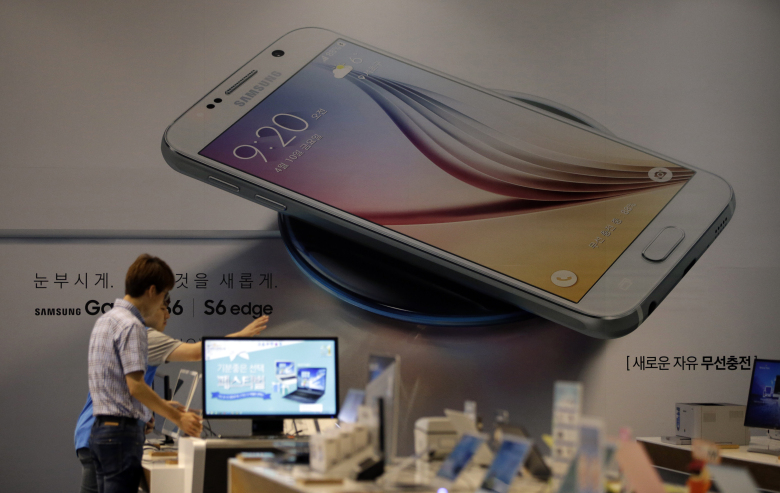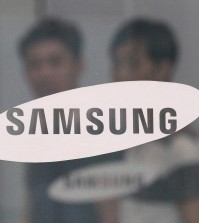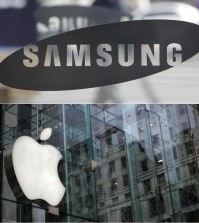- California Assembly OKs highest minimum wage in nation
- S. Korea unveils first graphic cigarette warnings
- US joins with South Korea, Japan in bid to deter North Korea
- LPGA golfer Chun In-gee finally back in action
- S. Korea won’t be top seed in final World Cup qualification round
- US men’s soccer misses 2nd straight Olympics
- US back on track in qualifying with 4-0 win over Guatemala
- High-intensity workout injuries spawn cottage industry
- CDC expands range of Zika mosquitoes into parts of Northeast
- Who knew? ‘The Walking Dead’ is helping families connect
With disappointing S6 sales, Samsung predicts fall in profits

Employees of Samsung Electronics Co. check the products near an advertisement of Samsung Electronics’ Galaxy S6 smartphone at a Samsung Electronics shop in Seoul, South Korea, Tuesday, July 7, 2015. Samsung Electronics Co. forecast lower-than-expected profit for the April-June quarter in a sign that its much-anticipated Galaxy S6 smartphones failed to lead a meaningful recovery.(AP Photo/Lee Jin-man)
SEOUL, South Korea (AP) — Samsung Electronics Co. forecast a fall in second quarter profit in a sign that sales of its much anticipated Galaxy S6 smartphones failed to meet expectations.
Samsung on Tuesday estimated its second quarter operating profit at 6.9 trillion won ($6.1 billion), down 4 percent from a year earlier. The result represents a 15 percent gain from the previous quarter but it was lower than the 7.23 trillion won forecast in a FactSet survey of analysts.
Sales declined 8 percent from a year earlier to 48 trillion won, falling short of the FactSet forecast of 52.8 trillion won. The South Korean company will release its full result for the quarter later this month.
When Samsung began sales of its Galaxy S6 and S6 Edge smartphones in April, there were expectations that the new flagship devices would lead a revival at Samsung’s handset business, which suffered a stunning decline last year.
It retained the title of the world’s largest maker of smartphones but its market share declined, squeezed by Apple in the premium market and by Chinese companies in the low-end market. Within Samsung, development of the Series 6 smartphones was dubbed “Project Zero,” signifying the company’s efforts to recapture the winning formula of its earlier phones.
Samsung was hit by two problems with its Galaxy S6 series. The regular version of the phone, the Galaxy S6, wasn’t as popular as expected, while the S6 Edge model, which features a display that curves on both sides that is more difficult to produce, couldn’t keep up with demand.
“The failure to manage the initial shipment for the Galaxy S6 series is the primary reason” for disappointing sales, said Lee Ka-keun, an analyst at KB Securities. “Demand for smartphones and other IT products were also weak.”
Samsung’s smartphone sales were also hit by a new law that was enforced in South Korea last year, which barred handset vendors from giving hefty subsidies to phone buyers. The measure has been a boon to Samsung’s rival Apple Inc., whose iPhone sales in South Korea grew. Apple’s newest models also featured larger screens that were similar in size to the Samsung phones, removing one of Samsung’s advantages.
Counterpoint Technology Market Research, a market research firm, said last month that Samsung sold 6 million Galaxy S6 and S6 Edge smartphones by the end of April, selling at a faster rate than its 2014 predecessor model.
But the research firm said the chance of Samsung’s flagship models overtaking Apple’s iPhone 6 series was small due to production constraints for the curved glass.
Analysts have lowered profit forecasts for Samsung in recent weeks citing the weaker-than-expected sales of its flagship smartphones. Last month, Nomura Securities cut its estimate of Samsung’s smartphone shipments during the second quarter to 75 million units, down 11 percent from its earlier forecast. Other brokerages also cut their forecasts.















